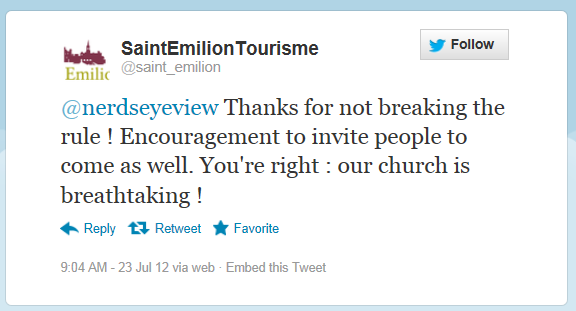Taking pictures was not allowed inside the monolithic church at St. Emilion. I thought I did not mind this because while I was gobstruck by sheer effort of building this cathedral into — and out of — solid rock, there was actually not very much to see. But then I turned around and underneath one of the Gothic arched windows, there was an altar. It was backlit from the outside, the sun leaked in through a gridded metal screen and some yellowing panes of heavy plastic. There were candles, a few lit in front of the statue. And the statue itself was a Gothic Mary, her neck too delicate to hold up her crowned head. She was a shadow, outlined, the points of her crown sharp against the yellow light and the checkerboard of the metal screen over the stone window.
I wanted a picture of that shadow. I considered breaking the rules, briefly, I would not use a flash, perhaps I could get away with it without anyone noticing. But I was a guest and I did not want to misbehave and embarrass my hosts. I stood and looked at that black outlined shape over the candle lit altar and thought, I will write about this later, I will remember what this looks like and try to draw a picture of it with my memory after I get home.
Our guide led us into the church compound through a heavy door that she opened with one of those keys that looks like it opens into a secret place. There was grotto to the left where clear water comes up from the ground, sparkling clear, and to the right, catacombs and then, the church itself. During the hot afternoon when my group visited, the church was cool and damp inside, standing next to an open air shaft in the courtyard an air conditioned blast of cold air reached for the sunlight. The ceilings of the church were high and arcaded; the pillars holding the weight of the bell tower above were wrapped in reinforcing metal supports. Stone bas relief angels flanked the main altar and there were a few weak remnants of the paint that once covered the entire church.
I was in France for the wine, but this church, carved into the rock of the village hillside, had me wildly distracted. I thought about Lalibela in Ethiopia, another place in the world where churches have been carved into stone, and Cappadoccia, in Turkey. I looked at the musicians over the main altar, they look unfinished, or perhaps damaged by time, but they were unmistakeable as musicians from another time. My brain buzzed with the simple idea that 1300 years ago, there was music in this town. My ukulele was back in my hotel room; what would it sound like inside this space?
There was not enough time and we had other places to be. I kept my camera in my pocket and we walked back out into the bright sunlight and up to the base of the bell tower to admire the view across the tiled rooftops of the village. The body of the church was below our feet, filled with cool air and the humidity of water pulled up through the limestone. The candlelit Madonna stayed at her altar, but her shadow, a black paper cutout with the points of her crown sharp in the backlit pointed arch of the window, came with me as a souvenir.
I was a guest of the Bordeaux Wine Council for this trip. Nearly all of my expenses were covered. And yes, I’d go back to Bordeaux in a heartbeat.



I was equally tempted to take pictures in this church! It was an amazing space.
My cousins live not far from Saint Emilion, and on a visit to see them in – 2004, I think? – cousin Pierre drove us over hill and dale one day, zipping from one unbelievably gorgeous view to the next, showing off all the fabulousness that was within a few minutes’ drive of the several-hundred-year-old farmhouse they’d just renovated. Sadly, this meant we got to spend all of twelve nanoseconds staring open-mouthed through the car windows at that church before Pierre had other things we needed to see, and we didn’t get back to Saint Emilion on that trip. I’ve wanted to go back ever since. Maybe it’s time to visit Pierre again, only this time we’ll do the driving.
Also? I love the Saint Emilion tourism people for that tweet.